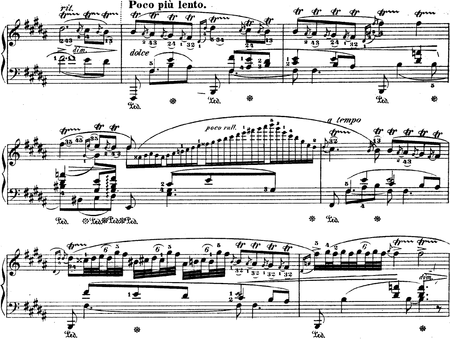Nocturnes, Op. 62 (Chopin)
The two Nocturnes Op. 62 by Frédéric Chopin were published in 1846 and dedicated to Mdlle. R. de Konneritz.[1]

Nocturne in B major, Op. 62, No. 1

One of his last works, the Nocturne in B major opens with what might be described as a bard's striking of the strings. After the simple introductory chords, a simple melody in B major emerges. At first, the action proceeds gently and smoothly (dolce, legato). But the song soon turns into declamation, led by a lofty, dramatic raised voice, and after a flashy scale in the right hand, Chopin leads us to the B section of this ternary formed (ABA) nocturne.
The middle section is filled by that sostenuto (in A flat major, rather foreign from the key of B major), but preceding this section, the music is hesitant and pauses. This B section then begins softly, not strong or explosive as is often the case in the middle section of a nocturne. On the contrary, it is slightly disturbed, inhibited, unease triggered by the play of syncopation of the left hand chords. Chopin ends the sostenuto with extreme harmonic subtlety and delicacy.
The main section of the Nocturne comes again by pivoting through the note D#/E-flat, which is re-understood from B section's A-flat to the home key of B major. Furthermore, this opening melody is embellished by continuous figuration including many trills, grace notes and runs. This embellishment is similar to an Italian da capo aria, in Italian bel canto style: when the principal melody returned, the singer had not just the right, but the duty to embellish it in the most elaborate way possible, flaunting his vocal skills.
The main theme ends with a solid resolution in B major, however there is a particularly long coda in this nocturne. This coda features a number of legato, languid arpeggi which never take us far from B major. Finally, the coda ends with a simple harmonic phrase which is quite peaceful, given the rather mysterious and enigmatic drama of the complex nocturne.
In the Anglo-Saxon world, the B major Nocturne has been given the name of an exotic greenhouse flower: ‘Tuberose’. James Huneker explains why: ‘the chief tune has charm, a fruity charm’, and its return in the reprise ‘is faint with a sick, rich odor’.

Nocturne in E major, Op. 62, No. 2



Nocturne in E major, Op. 62, No. 2 is a reflective and contrapuntally engaging nocturne and is a fine example of the refinement and contrapuntal richness of Chopin's later works. The nocturne's thematic structure (ABCAB) consists of a simple and slow primary theme in E major, followed by a thoughtful and more quickly moving secondary melodic theme with climbing bass runs. This leads to the agitated, loud, and contrapuntal third section in C# minor, which has melodic interplay between the LH and the RH top 3 fingers, with the RH thumb and first fingers largely playing accompaniment. After this agitated section, Chopin returns to the first and second themes via a dissonant F major arpeggio with a D# in the bass, leading to a B in the bass, the echoing of the initial bars of the piece, and the return to E major. This return of the first melody quickly gives way to the rolling bass 2nd theme, which leads smoothly into the coda. In their reprisal, these two melodic themes are accompanied by slightly differing harmonies with modified embellishment in the right hand, as is typical of A' section of ternary Chopin nocturnes. The nocturne ends with a simple coda re-affirming solidly the key of E major, a technique which is common in other nocturnes including Op. 62 No. 1 and Op. 9 No. 2.
External links
- Nocturnes Op. 62: Scores at the International Music Score Library Project (IMSLP)